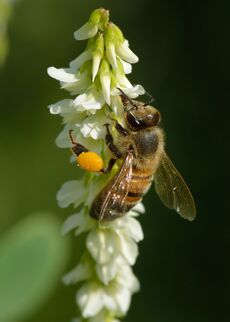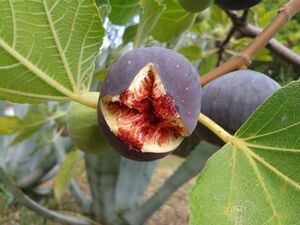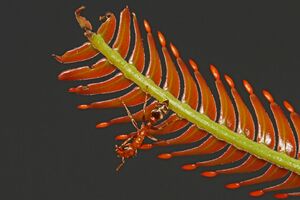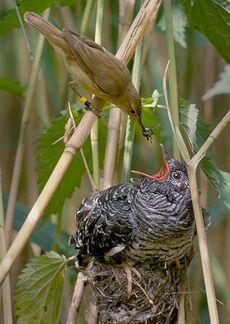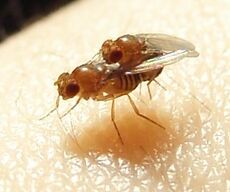“共同演化”的版本间的差异
| 第7行: | 第7行: | ||
[[File:Dasyscolia ciliata.jpg|thumb|upright=1.5|授粉的黄蜂 ''Dasyscolia ciliata'' 在与''Ophrys speculum''花进行拟交配<ref name=Pijl/>|链接=Special:FilePath/Dasyscolia_ciliata.jpg]] | [[File:Dasyscolia ciliata.jpg|thumb|upright=1.5|授粉的黄蜂 ''Dasyscolia ciliata'' 在与''Ophrys speculum''花进行拟交配<ref name=Pijl/>|链接=Special:FilePath/Dasyscolia_ciliata.jpg]] | ||
{{Evolutionary biology}} | {{Evolutionary biology}} | ||
| − | In biology, '''coevolution''' occurs when two or more species reciprocally affect each other's evolution through the process of natural selection. The term sometimes is used for two traits in the same species affecting each other's evolution, as well as gene-culture coevolution. | + | In biology, '''coevolution''' occurs when two or more species reciprocally affect each other's evolution through the process of natural selection. The term sometimes is used for two traits in the same species affecting each other's evolution, as well as gene-culture coevolution.在生物学中,当两个或多个物种通过自然选择过程相互影响彼此各自的演化时,就会发生'''共同演化'''。该词语有时用在同一物种中存在相互影响和演化的两个特征上,例如基因和文化的共同演化。 |
[[Charles Darwin]] mentioned evolutionary interactions between [[flowering plant]]s and [[insect]]s in ''[[On the Origin of Species]]'' (1859). Although he did not use the word coevolution, he suggested how plants and insects could evolve through reciprocal evolutionary changes. Naturalists in the late 1800s studied other examples of how interactions among species could result in reciprocal evolutionary change. Beginning in the 1940s, plant pathologists developed breeding programs that were examples of human-induced coevolution. Development of new crop plant varieties that were resistant to some diseases favored rapid evolution in pathogen populations to overcome those plant defenses. That, in turn, required the development of yet new resistant crop plant varieties, producing an ongoing cycle of reciprocal evolution in crop plants and diseases that continues to this day. | [[Charles Darwin]] mentioned evolutionary interactions between [[flowering plant]]s and [[insect]]s in ''[[On the Origin of Species]]'' (1859). Although he did not use the word coevolution, he suggested how plants and insects could evolve through reciprocal evolutionary changes. Naturalists in the late 1800s studied other examples of how interactions among species could result in reciprocal evolutionary change. Beginning in the 1940s, plant pathologists developed breeding programs that were examples of human-induced coevolution. Development of new crop plant varieties that were resistant to some diseases favored rapid evolution in pathogen populations to overcome those plant defenses. That, in turn, required the development of yet new resistant crop plant varieties, producing an ongoing cycle of reciprocal evolution in crop plants and diseases that continues to this day. | ||
2022年5月20日 (五) 22:46的版本
此词条由Danny生产
此词条暂由彩云小译翻译,翻译字数共3648,未经人工整理和审校,带来阅读不便,请见谅。
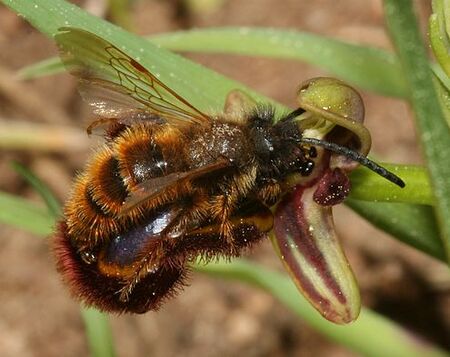
模板:Evolutionary biology In biology, coevolution occurs when two or more species reciprocally affect each other's evolution through the process of natural selection. The term sometimes is used for two traits in the same species affecting each other's evolution, as well as gene-culture coevolution.在生物学中,当两个或多个物种通过自然选择过程相互影响彼此各自的演化时,就会发生共同演化。该词语有时用在同一物种中存在相互影响和演化的两个特征上,例如基因和文化的共同演化。
Charles Darwin mentioned evolutionary interactions between flowering plants and insects in On the Origin of Species (1859). Although he did not use the word coevolution, he suggested how plants and insects could evolve through reciprocal evolutionary changes. Naturalists in the late 1800s studied other examples of how interactions among species could result in reciprocal evolutionary change. Beginning in the 1940s, plant pathologists developed breeding programs that were examples of human-induced coevolution. Development of new crop plant varieties that were resistant to some diseases favored rapid evolution in pathogen populations to overcome those plant defenses. That, in turn, required the development of yet new resistant crop plant varieties, producing an ongoing cycle of reciprocal evolution in crop plants and diseases that continues to this day.
1859年,查尔斯·达尔文在他的著作物种起源中提到了被子植物和昆虫之间的进化互动。尽管他没有使用共同进化这个词,但他提出了植物和昆虫是如何通过相互进化的改变而演化的。19世纪晚期的博物学家研究了物种间的交互如何导致彼此演变的其他例子。从20世纪40年代开始的由植物病理学家开发的育种程序就是人类诱导共同进化的例子。培育能够抵抗某些疾病作物的新品种有利于病原体种群的快速进化以克服作物的这些抵御。这反过来又需要开发新的抗性作物品种,这样就造成了在作物和疾病之间的一个持续共同演化的循环;如此的循环一直持续到了今天。
Coevolution as a major topic for study in nature expanded rapidly after the middle 1960s, when Daniel H. Janzen showed coevolution between acacias and ants (see below) and Paul R. Ehrlich and Peter H. Raven suggested how coevolution between plants and butterflies may have contributed to the diversification of species in both groups. The theoretical underpinnings of coevolution are now well-developed (e.g., the geographic mosaic theory of coevolution), and demonstrate that coevolution can play an important role in driving major evolutionary transitions such as the evolution of sexual reproduction or shifts in ploidy. More recently, it has also been demonstrated that coevolution can influence the structure and function of ecological communities, the evolution of groups of mutualists such as plants and their pollinators, and the dynamics of infectious disease.
共同演化作为自然界研究的一个主要课题,在20世纪60年代中期之后迅速扩大,丹尼尔·H·詹森(Daniel H. Janzen)展示了金合欢和蚂蚁之间的共同演化(见下文),保罗·R·埃利希(Paul R. Ehrlich)和彼得·H·雷文(Peter H. Raven)提出植物和蝴蝶之间的共同演化可能促进了两个群体的物种多样化。如今共同进化的理论基础已经颇为成熟(例如共同进化的地理镶嵌理论),而且向我们表明了共同演化在推动主要的进化转变中扮演着重要的角色,例如有性生殖的演化或者倍性的变化。[2][3]最近,共同进化也被证实可以影响生态群落的结构和功能以及共生群体的演化,例如植物和它们的传粉者,以及传染病的动态过程。[3][4]
Each party in a coevolutionary relationship exerts selective pressures on the other, thereby affecting each other's evolution. Coevolution includes many forms of mutualism, host-parasite, and predator-prey relationships between species, as well as competition within or between species. In many cases, the selective pressures drive an evolutionary arms race between the species involved. Pairwise or specific coevolution, between exactly two species, is not the only possibility; in multi-species coevolution, which is sometimes called guild or diffuse coevolution, several to many species may evolve a trait or a group of traits in reciprocity with a set of traits in another species, as has happened between the flowering plants and pollinating insects such as bees, flies, and beetles. There are a suite of specific hypotheses on the mechanisms by which groups of species coevolve with each other.
共同演化关系中的每一方都会向对方施加选择压,从而影响彼此的演化。共同演化包括各种形式的互利共生、宿主-寄生、物种间的捕食-被捕食关系以及物种内部或物种间的竞争。在许多情况下,选择压驱动了相关物种之间进化的较量。在特定两个物种之间中,两两和单独的共同演化的存在并不是唯一的可能;在多物种共同演化,有时被称为散协同演化中,几个到多个物种可能进化出同一个特征或同一组特征,这些特征与另一个物种的一系列特征相互作用,就像被子植物与蜜蜂、苍蝇和甲虫等传粉昆虫之间发生的情况那样。关于物种群之间共同进化的机制,有一套具体的假说。[5]
Coevolution is primarily a biological concept, but researchers have applied it by analogy to fields such as computer science, sociology, and astronomy.
共同进化最初是一个生物学概念,但研究人员已将其应用于计算机科学、社会学和天文学等领域。
互惠关系
Coevolution is the evolution of two or more species which reciprocally affect each other, sometimes creating a mutualistic relationship between the species. Such relationships can be of many different types.
共同演化是两个或两个以上物种相互影响,有时在物种之间创造一种互惠关系的演化。这样的关系可以有许多不同的类型。[6][7]
被子植物
Flowers appeared and diversified relatively suddenly in the fossil record, creating what Charles Darwin described as the "abominable mystery" of how they had evolved so quickly; he considered whether coevolution could be the explanation. He first mentioned coevolution as a possibility in On the Origin of Species, and developed the concept further in Fertilisation of Orchids (1862).
花朵在化石记录中比较突发地出现和多样化,创造了被查尔斯 · 达尔文描述为如此迅速进化的“令人憎恶的神秘”; 他考虑是否可以以共同演化作为解释。[8]他可能在物种起源中首次提到了共同演化,并在兰花的传粉(1862)中进一步发展了这个概念。[9][10][11][12]
昆虫和昆虫传粉的花朵
Modern insect-pollinated (entomophilous) flowers are conspicuously coadapted with insects to ensure pollination and in return to reward the pollinators with nectar and pollen. The two groups have coevolved for over 100 million years, creating a complex network of interactions. Either they evolved together, or at some later stages they came together, likely with pre-adaptations, and became mutually adapted.
现代昆虫传粉的花朵明显与昆虫相互适应以确保授粉,并以花蜜和花粉回馈授粉者。这两组群体已经共同演化了超过1亿年,创造了一个复杂的互动网络。它们要么一同演化,要么在后期的某些阶段一同演化——并很可能伴随着预适应,在之后达到了如此充分的相互适应性。[13][14]
Several highly successful insect groups—especially the Hymenoptera (wasps, bees and ants) and Lepidoptera (butterflies and moths) as well as many types of Diptera (flies) and Coleoptera (beetles)—evolved in conjunction with flowering plants during the Cretaceous (145 to 66 million years ago). The earliest bees, important pollinators today, appeared in the early Cretaceous. A group of wasps sister to the bees evolved at the same time as flowering plants, as did the Lepidoptera. Further, all the major clades of bees first appeared between the middle and late Cretaceous, simultaneously with the adaptive radiation of the eudicots (three quarters of all angiosperms), and at the time when the angiosperms became the world's dominant plants on land.
一些非常成功的昆虫群体——尤其是膜翅目(黄蜂、蜜蜂和蚂蚁)和鳞翅目(蝴蝶和飞蛾)以及许多种双翅目(苍蝇)和鞘翅目(甲虫)——在白垩纪(1.45亿至6.6亿年前)与被子植物共同演化。最早的蜜蜂,今天重要的传粉者,出现在白垩纪早期。[15]一群与蜜蜂相近亲的黄蜂与被子植物同时演化,鳞翅目也是如此。[15]此外,所有主要的蜜蜂分支种系均首次出现在白垩纪中到晚期间,同时出现的是真根植物的辐射适应(占所有被子植物的四分之三) ,正当被子植物成为世界上陆地的主要植物时。[9]
At least three aspects of flowers appear to have coevolved between flowering plants and insects, because they involve communication between these organisms. Firstly, flowers communicate with their pollinators by scent; insects use this scent to determine how far away a flower is, to approach it, and to identify where to land and finally to feed. Secondly, flowers attract insects with patterns of stripes leading to the rewards of nectar and pollen, and colours such as blue and ultraviolet, to which their eyes are sensitive; in contrast, bird-pollinated flowers tend to be red or orange. Thirdly, flowers such as some orchids mimic females of particular insects, deceiving males into pseudocopulation.
被子植物的花至少在三个方面呈现出和昆虫的共同演化,因为它们涉及到了这些有机体之间的交流。首先,花朵通过气味与它们的传粉者交流;昆虫通过这种气味来确定与一朵花的距离和靠近它,并决定在哪落足以及到最后在哪觅食。其次,吸引昆虫的花纹和图案导向花蜜和花粉的奖励;而蓝色和紫外线等色调则面向视觉灵敏的诱导授粉的目标;与此相对的是,通过鸟类传粉的花朵会更倾向于是红色或橙色的。再次,像某些兰花这样的花朵会模仿某些昆虫的雌性,欺骗雄性进入拟交配。[15][1]
The yucca, Yucca whipplei, is pollinated exclusively by Tegeticula maculata, a yucca moth that depends on the yucca for survival. The moth eats the seeds of the plant, while gathering pollen. The pollen has evolved to become very sticky, and remains on the mouth parts when the moth moves to the next flower. The yucca provides a place for the moth to lay its eggs, deep within the flower away from potential predators.
对丝兰(Yucca whipplei)这种植物只有斑点豆斑蛾才能够为其授粉,而斑点豆斑蛾是一种依靠丝兰生存的丝兰蛾。[16][17]花粉会随附在蛾进食植物的种子的过程之中被采集。花粉已经进化得非常粘着,当飞蛾移动到下一朵花时仍然会留在其口腔的部分。丝兰则在花的深处为蛾提供了一个产卵的地方,来远离潜在的捕食者。
鸟类和鸟类传粉的花朵
Hummingbirds and ornithophilous (bird-pollinated) flowers have evolved a mutualistic relationship. The flowers have nectar suited to the birds' diet, their color suits the birds' vision and their shape fits that of the birds' bills. The blooming times of the flowers have also been found to coincide with hummingbirds' breeding seasons. The floral characteristics of ornithophilous plants vary greatly among each other compared to closely related insect-pollinated species. These flowers also tend to be more ornate, complex, and showy than their insect pollinated counterparts. It is generally agreed that plants formed coevolutionary relationships with insects first, and ornithophilous species diverged at a later time. There is not much scientific support for instances of the reverse of this divergence: from ornithophily to insect pollination. The diversity in floral phenotype in ornithophilous species, and the relative consistency observed in bee-pollinated species can be attributed to the direction of the shift in pollinator preference.
蜂鸟和喜鸟类(通过鸟类传粉)的花演化出了一种互惠的关系。这些花的花蜜合于鸟类的饮食,它们的颜色亦合于鸟类的视觉,它们的形状则合于鸟的喙。这些花的开放时间还被发现与蜂鸟的繁殖季节相吻合。同与被昆虫传粉密切相关的植物相比,喜鸟类植物的花部特征差异很大。这些花也会较昆虫授粉的同类更华丽、复杂和艳丽。被普遍认为的是,植物首先与昆虫形成共同演化关系,喜鸟类植物在后期分化。从鸟类学到昆虫授粉,并没有多少科学依据支持此分歧中相反的例子。喜鸟类植物花器官表型的多样性和蜜蜂传粉物种花器官表型的相对一致性可以归因于传粉者偏好的转变方向。[18]
Flowers have converged to take advantage of similar birds. Flowers compete for pollinators, and adaptations reduce unfavourable effects of this competition. The fact that birds can fly during inclement weather makes them more efficient pollinators where bees and other insects would be inactive. Ornithophily may have arisen for this reason in isolated environments with poor insect colonization or areas with plants which flower in the winter. Bird-pollinated flowers usually have higher volumes of nectar and higher sugar production than those pollinated by insects. This meets the birds' high energy requirements, the most important determinants of flower choice. In Mimulus, an increase in red pigment in petals and flower nectar volume noticeably reduces the proportion of pollination by bees as opposed to hummingbirds; while greater flower surface area increases bee pollination. Therefore, red pigments in the flowers of Mimulus cardinalis may function primarily to discourage bee visitation. In Penstemon, flower traits that discourage bee pollination may be more influential on the flowers' evolutionary change than 'pro-bird' adaptations, but adaptation 'towards' birds and 'away' from bees can happen simultaneously. However, some flowers such as Heliconia angusta appear not to be as specifically ornithophilous as had been supposed: the species is occasionally (151 visits in 120 hours of observation) visited by Trigona stingless bees. These bees are largely pollen robbers in this case, but may also serve as pollinators.
花朵聚集在一起以利用同类鸟的优势。[19]花朵为了传粉者而相互竞争,而适应性减少了这种竞争的不利影响。鸟类可以在恶劣天气下飞行,这一事实使它们在蜜蜂和其他昆虫不活跃的地方成为更有效的授粉者。由于这个原因,鸟媒花在处在昆虫定居或植物较少的孤立环境中的冬季开放的花朵中更容易会出现。[19][20]鸟类传粉的花朵通常比昆虫传粉的花朵有更多的花蜜和更高的糖分产量。[21]这也正迎合了鸟类高能量的需求,作为了花在面临自然选择时最重要的决定因素[21]。在沟酸浆属中,花瓣中红色素和花蜜产量的增加明显减少了蜜蜂授粉的比例,而对于蜂鸟则相反;同时花朵表面积越大蜜蜂授粉的比例也就越高。因此,红雀花中的红色色素可能主要起到抑制蜜蜂拜访的作用。[22]在钓钟柳中,阻碍蜜蜂授粉的花朵特征可能比“支持鸟类”的适应性对花朵进化变化的影响更大,但是“亲和”鸟类和“疏离”蜜蜂的适应性变化可以同时发生[23]。然而,一些花,如海里康属的大鹤望兰似乎并不像人们想象的那样特别喜好鸟类:这个物种偶尔(在120小时的观察中被造访了151次)被无刺的无刺针属的蜜蜂拜访。在这种情况下,这些蜜蜂更多是作为了花粉盗窃者,但也可能充当传粉者。[24]
Following their respective breeding seasons, several species of hummingbirds occur at the same locations in North America, and several hummingbird flowers bloom simultaneously in these habitats. These flowers have converged to a common morphology and color because these are effective at attracting the birds. Different lengths and curvatures of the corolla tubes can affect the efficiency of extraction in hummingbird species in relation to differences in bill morphology. Tubular flowers force a bird to orient its bill in a particular way when probing the flower, especially when the bill and corolla are both curved. This allows the plant to place pollen on a certain part of the bird's body, permitting a variety of morphological co-adaptations.
在各自的繁殖季节之后,几种蜂鸟出现在北美的同一地点,而这几种蜂鸟的花同时也在这些栖息地开放。这些花聚集在共同的一个形态和颜色,因为这些形态和颜色能够有效地吸引鸟类。蜂鸟喙形态的不同决定了花冠管的长度和曲率对蜂鸟提取效率的影响。管状花朵迫使鸟类在寻找花朵时以一种特殊的方式来调整喙的方向,尤其是当喙和花冠都是弯曲的时候。这允许了植物可以把花粉携于鸟身体的某一部分,从而实现了各种形态上的协同适应。[21]
Ornithophilous flowers need to be conspicuous to birds. Birds have their greatest spectral sensitivity and finest hue discrimination at the red end of the visual spectrum, so red is particularly conspicuous to them. Hummingbirds may also be able to see ultraviolet "colors". The prevalence of ultraviolet patterns and nectar guides in nectar-poor entomophilous (insect-pollinated) flowers warns the bird to avoid these flowers. Each of the two subfamilies of hummingbirds, the Phaethornithinae (hermits) and the Trochilinae, has evolved in conjunction with a particular set of flowers. Most Phaethornithinae species are associated with large monocotyledonous herbs, while the Trochilinae prefer dicotyledonous plant species.
喜鸟类的花需要引起鸟的注意。[21]鸟类的视觉光谱在红色一端拥有极好的色调辨别能力和最强的光谱敏感性[21],所以红色对它们来说特别显眼;蜂鸟可能也可以看到紫外线的“颜色”。在缺少花蜜的昆虫传粉的花朵中,紫外线图案和花蜜的流行会向导和警告鸟类去避开这些花。[21]蜂鸟的每两亚科——隐蜂鸟亚科(hermits)和蜂鸟亚科的每一个亚科都与一组特定的花一同演化。大多数种类与大型单子叶植物有关,而金线菊亚科更喜欢双子叶植物。[21]
无花果的生殖与无花果蜂
The genus Ficus is composed of 800 species of vines, shrubs, and trees, including the cultivated fig, defined by their syconiums, the fruit-like vessels that either hold female flowers or pollen on the inside. Each fig species has its own fig wasp which (in most cases) pollinates the fig, so a tight mutual dependence has evolved and persisted throughout the genus.花的容器,里面装着雌花或花粉
榕属植物由800种藤本植物、灌木和乔木构成,其中包括栽培的无花果、由它们可以保持雌花和花粉在其中的果实状萼的榕果所定义。每一种榕树都有自己的榕小蜂(在大多数情况下)为榕树授粉,由此一种贯穿于这个属中紧密的相互依赖关系已然形成并持续存在。[25]
相思树蚁与牛角相思树
The acacia ant (Pseudomyrmex ferruginea) is an obligate plant ant that protects at least five species of "Acacia" (Vachellia)模板:Efn from preying insects and from other plants competing for sunlight, and the tree provides nourishment and shelter for the ant and its larvae. Such mutualism is not automatic: other ant species exploit trees without reciprocating, following different evolutionary strategies. These cheater ants impose important host costs via damage to tree reproductive organs, though their net effect on host fitness is not necessarily negative and, thus, becomes difficult to forecast.
相思树蚁(Pseudomyrmex ferruginea)是一种能保护至少5种金合欢树(Vachellia)免受食用牛角相思树的昆虫和其他植物争夺阳光的专性植物蚂蚁,而这种树则为这种蚂蚁及其幼虫提供营养和庇护[26][27]。这种互利共生并不是自然而然的:其他蚂蚁种类遵循不同的进化策略,利用树木而不作回报;这些欺诈性的蚂蚁通过破坏树木的生殖器官对寄主施加重大伤害,不过它们对寄主健康的净影响并不一定是负面的,因此难以预测。[28][29]
宿主和寄生虫
寄生虫和有性生殖的宿主
Host–parasite coevolution is the coevolution of a host and a parasite. A general characteristic of many viruses, as obligate parasites, is that they coevolved alongside their respective hosts. Correlated mutations between the two species enter them into an evolution arms race. Whichever organism, host or parasite, that cannot keep up with the other will be eliminated from their habitat, as the species with the higher average population fitness survives. This race is known as the Red Queen hypothesis. The Red Queen hypothesis predicts that sexual reproduction allows a host to stay just ahead of its parasite, similar to the Red Queen's race in Through the Looking-Glass: "it takes all the running you can do, to keep in the same place". The host reproduces sexually, producing some offspring with immunity over its parasite, which then evolves in response.
宿主和寄生者的共同演化是宿主和寄生者的共同演化。[30]许多病毒作为专性寄生者的一个普遍特征是它们与各自宿主的共同演化。这两个物种之间的相关突变使它们进入了进化的军备竞赛。无论是哪种生物、宿主或寄生物,如果不能跟上其他生物的步伐,它们就会从它们的栖息地消失,而平均适合度较高的物种会幸存下来。这种竞争的假说被称为红皇后假说。[31]红皇后假说预测有性生殖可以让寄主在寄生者之前保持领先,就像爱丽丝镜中奇遇的红皇后比赛一样:“尽你所能跑而仍保留在同一个地方。”。[32]宿主进行有性繁殖,产生一些对寄生物具有免疫力的后代,然后进化为应对措施。[33]
The parasite–host relationship probably drove the prevalence of sexual reproduction over the more efficient asexual reproduction. It seems that when a parasite infects a host, sexual reproduction affords a better chance of developing resistance (through variation in the next generation), giving sexual reproduction variability for fitness not seen in the asexual reproduction, which produces another generation of the organism susceptible to infection by the same parasite. Coevolution between host and parasite may accordingly be responsible for much of the genetic diversity seen in normal populations, including blood-plasma polymorphism, protein polymorphism, and histocompatibility systems.
寄生者和宿主的关系可能导致了有性生殖的流行,而不是更有效率的无性生殖。看起来,当寄生者感染宿主时,有性生殖提供了一个更好的机会来发展抵抗性(通过下一代的变异) ,这种可导致适应性的有性生殖变异性在无性生殖中则看不到,这样就更容易会产生另一代易受同一寄生者的感染的机体。[34][35][36]宿主和寄生者之间的共同演化可能相应导致了在普遍的群体中的许多遗传多样性,包括血浆多态性、蛋白多态性和组织相容性系统。[37]
巢穴寄生
Brood parasitism demonstrates close coevolution of host and parasite, for example in some cuckoos. These birds do not make their own nests, but lay their eggs in nests of other species, ejecting or killing the eggs and young of the host and thus having a strong negative impact on the host's reproductive fitness. Their eggs are camouflaged as eggs of their hosts, implying that hosts can distinguish their own eggs from those of intruders and are in an evolutionary arms race with the cuckoo between camouflage and recognition. Cuckoos are counter-adapted to host defences with features such as thickened eggshells, shorter incubation (so their young hatch first), and flat backs adapted to lift eggs out of the nest.
巢穴寄生表明了宿主和寄生者密切的共同演化,例如一些杜鹃。这些鸟不自己筑巢,而是在其他物种的巢中产卵,排除或杀死寄主的卵和幼鸟,从而对寄主的生殖良性产生严重的负面影响。它们的卵伪装成它们寄主的卵,这意味寄主是能够区分自己的卵和入侵者的卵的,并且与杜鹃处于一种伪装和识别之间进化的军备竞赛中。杜鹃与寄主相反,具有加厚的蛋壳、较短的孵化期(所以它们的幼鸟会先孵化)和适于将蛋提出巢外的平脊等特征。[38][39][40]
拮抗性的共同演化
Antagonistic coevolution is seen in the harvester ant species Pogonomyrmex barbatus and Pogonomyrmex rugosus, in a relationship both parasitic and mutualistic. The queens are unable to produce worker ants by mating with their own species. Only by crossbreeding can they produce workers. The winged females act as parasites for the males of the other species as their sperm will only produce sterile hybrids. But because the colonies are fully dependent on these hybrids to survive, it is also mutualistic. While there is no genetic exchange between the species, they are unable to evolve in a direction where they become too genetically different as this would make crossbreeding impossible.
拮抗性的共同演化关系在红收获蚁(Pogonomyrmex barbatus)和罗纹须蚁(Pogonomyrmex rugosus)之间可以看到,它们之间既有寄生关系也有互惠关系。蚁后无法通过与同类交配来繁殖工蚁。只有通过杂交,它们才能繁殖工蚁。有翅膀的雌性对其他物种的雄性像寄生一样,因为它们的精子只会繁殖不育的杂种。但由于殖民完全依赖于这些杂交种的生存,这也是互惠互利的。虽然两个物种之间没有基因交换,但它们不能朝向基因差异太大的方向演化,因为这将使杂交繁殖变得不可能。[41]
捕食者和猎物
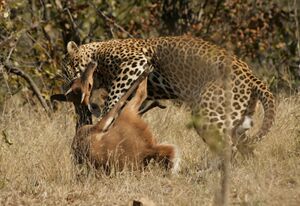
Predators and prey interact and coevolve: the predator to catch the prey more effectively, the prey to escape. The coevolution of the two mutually imposes selective pressures. These often lead to an evolutionary arms race between prey and predator, resulting in anti-predator adaptations.
捕食者和猎物互动并共同演化:捕食者去更有效地捕捉猎物,猎物去逃离追捕。两者的共同演化相互施加这一选择压。这往往导致猎物和捕食者之间的进化军备竞赛,并导致反捕食者适应。[42]
The same applies to herbivores, animals that eat plants, and the plants that they eat. Paul R. Ehrlich and Peter H. Raven in 1964 proposed the theory of escape and radiate coevolution to describe the evolutionary diversification of plants and butterflies. In the Rocky Mountains, red squirrels and crossbills (seed-eating birds) compete for seeds of the lodgepole pine. The squirrels get at pine seeds by gnawing through the cone scales, whereas the crossbills get at the seeds by extracting them with their unusual crossed mandibles. In areas where there are squirrels, the lodgepole's cones are heavier, and have fewer seeds and thinner scales, making it more difficult for squirrels to get at the seeds. Conversely, where there are crossbills but no squirrels, the cones are lighter in construction, but have thicker scales, making it more difficult for crossbills to get at the seeds. The lodgepole's cones are in an evolutionary arms race with the two kinds of herbivore.
这同样适用于草食动物、植食动物,以及它们吃的植物。1964年,保罗·R·欧里希和彼得·R·瑞文提出了逃逸和辐射的共同演化理论来描述植物和蝴蝶的进化多样性。[43]在落基山脉,红松鼠和斑鸠(食种子的鸟)争夺海滩松的种子。松鼠通过啃咬松果鳞片来获取松子,而斑鸠则通过它们不寻常的交叉下颚来获取松子。在有松鼠的地方,海滩松的球果更重、种子更少、鳞片更薄,这使得松鼠更加难以获取种子。相反,如果有斑鸠而没有松鼠,球果的结构会较轻,但有较厚的鳞片,从而就导致交喙更难获取种子。海滩上的锥形细胞与这两种食草动物进行着一场进化中的军备竞赛,在接下来的两个段落中也是这样。[44]
竞争行为
Both intraspecific competition, with features such as sexual conflict and sexual selection, and interspecific competition, such as between predators, may be able to drive coevolution.
无论是具有如性冲突[45]和性选择[46]等特征的种内竞争,还是具有如食肉动物之间的种间竞争,都可能推动共同演化。[47]
多物种
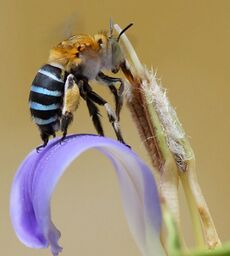
The types of coevolution listed so far have been described as if they operated pairwise (also called specific coevolution), in which traits of one species have evolved in direct response to traits of a second species, and vice versa. This is not always the case. Another evolutionary mode arises where evolution is reciprocal, but is among a group of species rather than exactly two. This is variously called guild or diffuse coevolution. For instance, a trait in several species of flowering plant, such as offering its nectar at the end of a long tube, can coevolve with a trait in one or several species of pollinating insects, such as a long proboscis. More generally, flowering plants are pollinated by insects from different families including bees, flies, and beetles, all of which form a broad guild of pollinators which respond to the nectar or pollen produced by flowers.
到目前为止,所列出的共同演化类型均是被描述为两两而作用的(也称为特定的共同演化)——其中一个物种的特征直接响应第二个物种特征而演化;反之亦然。然而现实当中所遇到的共同演化并非总是如此。另一种演化模式出现在相互演化之处,然而是在一组物种而不是两个物种之间。这被称作为泛协同性(集团性)的或散漫的共同演化。例如,几种开花植物例如在长管的末端提供花蜜的特征可以与一种或几种传粉昆虫例如长喙的特征共同演化。更一般地说,被子植物是由来自不同科的昆虫授粉的,包括蜜蜂、苍蝇和甲虫,所有这些昆虫形成了一个广泛的授粉的协同系统,它们对花朵产生的花蜜或花粉作出反应。[48][49][50]
地理镶嵌理论
The geographic mosaic theory of coevolution was developed by John N. Thompson as a way of linking the ecological and evolutionary processes that shape interactions among species across ecosystems. It is based on three observations that are taken as assumptions: (1) species are usually groups of populations that are somewhat genetically distinct from each other, (2) interacting species often co-occur in only parts of their geographic ranges, and (3) interactions among species differ ecologically among environments.
共同演化的地理镶嵌理论是由约翰·N·汤普森发展起来的,作为一种连接塑造生态系统中物种间互动的生态和进化过程的方式。它基于三个观察所得的假设:(1)这些物种通常是在基因上各所不同的种群,(2)互动的物种经常只是共同出现在它们地理范围的部分,以及(3)种间的互动在生态上发生分歧于环境的不同。
From these assumptions, geographic mosaic theory suggests that natural selection on interactions among species is driven by three sources of variation:
根据这些假设的地理镶嵌理论表明物种间相互作用的自然选择由三个变异来源驱动:
1. Geographic selection mosaics occur in interactions among species, because genes are expressed in different ways in different environments and because different genes are favored in different environments. For example, natural selection on an interaction between a parasite population and a host population may differ between very dry environments and very wet environments. Alternatively, an interaction between two or more species may be antagonistic in some environments but mutualistic (beneficial to both or all species) in other environments.
- 地理选择镶嵌发生在物种的相互作用之间;因为基因在不同的环境中以不同的方式表达,而且不同的基因会在不同的环境中各受欢迎。例如,寄生虫种群和宿主种群之间相互作用的自然选择在非常干燥的环境和非常湿润的环境之间可能有所不同。或者,两个或两个以上物种之间的相互作用在某些环境中可能是对抗性的,但在其他环境中是互惠性的(对两个或所有物种都有益)。
2. Coevolutionary hotspots and coldspots occur because natural selection on interactions among species is reciprocal in some environments but not in others. For example, a symbiont population may decrease the survival or reproduction of its hosts in one environment, but it may have no effect on host survival or reproduction in another environment. When detrimental, natural selection will favor evolutionary responses in the host population, resulting in a coevolutionary hotspot of ongoing reciprocal evolutionary changes in the parasite and host populations. When the symbiont has no effect on the survival and reproduction of the host, natural selection on the symbiont population will not favor an evolutionary response by the host population (i.e, a coevolutionary coldspot).
2. 共同演化的热点和冷点的出现是因为物种间相互作用的自然选择在某些环境中是相互的,而在其他环境中则不然。例如,一个共生的生物种群可能会损害其宿主在一个环境中的生存或繁殖,但它可能对宿主在另一个环境中的生存或繁殖没有影响。当这一影响是负面的时候,自然选择将有利于宿主种群的进化反应,从而导致寄生虫和宿主种群中正在进行的相互演变的共同演化热点。当共生对宿主的生存和繁殖没有影响时,共生生物种群的自然选择则会不利于宿主种群的进化反应(即共同演化的冷点)。
3. Finally, there is constant remixing of the traits on which natural selection acts both locally and regionally. At any moment in time, a local population will have a unique combination of genes on which natural selection acts. These genetic differences among populations occur because each local population has a unique history of new mutations, genomic alterations (e.g., whole genome duplications), gene flow among populations from individuals arriving from other populations or going to other populations, random loss or fixation of genes at times when populations are small (random genetic drift), hybridization with other species, and other genetic and ecological processes that affect the raw genetic material on which natural selection acts. More formally, then, the geographic mosaic of coevolution can be viewed as a genotype by genotype by environment interaction (GxGxE) that results in the relentless evolution of interacting species.
3. 最后,自然选择作用在局部和区域两方面的特征-不断-重新混合。在任何时候,当地的种群都会有一个自然选择作用的独特基因组合。这些种群之间的遗传差异之所以会出现,是因为每个当地种群都有新的突变、基因组的改变(例如全基因组复制)、来自其他种群个体或个体朝向其他种群的种间基因流、在种群规模较小时随机丢失或加强的基因(随机遗传漂变)、与其他种群的杂交,以及影响自然选择之作用的原始遗传物质的其他遗传和生态过程。更正式地说,共同演化的地理镶嵌可被看作是一种基因型与环境的相互作用(GxGxE),这种作用导致了相互作用物种的无向演化。
Geographic mosaic theory has been explored through a wide range of mathematical models, studies of interacting species in nature, and laboratory experiments using microbial species and viruses.
地理镶嵌理论已经通过广泛的数学模型、研究自然界中相互作用的物种,以及使用微生物物种和病毒的实验室实验得到探索。[5][2]
在生物学之外
Coevolution is primarily a biological concept, but has been applied to other fields by analogy.
共同演化是一个生物学的概念,但已经类推至其他领域。
在算法中
Coevolutionary algorithms are used for generating artificial life as well as for optimization, game learning and machine learning. Daniel Hillis added "co-evolving parasites" to prevent an optimization procedure from becoming stuck at local maxima. Karl Sims coevolved virtual creatures.
协同演化性的算法已经应用于生成人工生命;以及优化、博弈学习和机器学习等方面。[51][52][53][54][55]丹尼尔希尔斯引进“共同进化寄生虫”防止优化过程陷入局部极大值。[56]卡尔西姆斯将这一概念用至了虚拟生物上面。[57]
在建筑学中
The concept of coevolution was introduced in architecture by the Danish architect-urbanist Henrik Valeur as an antithesis to "star-architecture". As the curator of the Danish Pavilion at the 2006 Venice Biennale of Architecture, he created an exhibition-project on coevolution in urban development in China; it won the Golden Lion for Best National Pavilion.
共同进化的概念被丹麦建筑师兼城市规划专家亨利克 · 瓦勒尔在建筑学引入,作为“星架构”[58]的对立面。作为2006年威尼斯建筑双年展丹麦馆的馆长,他创建了一个关于中国城市发展共同进化的展览项目,并获得了最佳国家馆的金狮奖。[59][60][61][62]
At the School of Architecture, Planning and Landscape, Newcastle University, a coevolutionary approach to architecture has been defined as a design practice that engages students, volunteers and members of the local community in practical, experimental work aimed at "establishing dynamic processes of learning between users and designers."
在纽卡斯尔大学的建筑、规划和景观学院,共同进化方法的建筑学被定义为让学生、志愿者和当地社区的成员参与实际的、实验性的工作的一种设计实践,旨在“建立用户和设计师之间的动态学习过程”。[63]
在宇宙学和天文学中
In his book The Self-organizing Universe, Erich Jantsch attributed the entire evolution of the cosmos to coevolution.
在自组织的宇宙一书中,埃里希·詹茨把整个宇宙的演化归因于共同进化。
In astronomy, an emerging theory proposes that black holes and galaxies develop in an interdependent way analogous to biological coevolution.
在天文学中,一个新兴的理论提出黑洞和星系以一种相互依存的方式生存,类似于生物的共同演化。[64]
在管理和组织研究中
Since year 2000, a growing number of management and organization studies discuss coevolution and coevolutionary processes. Even so, Abatecola el al. (2020) reveals a prevailing scarcity in explaining what processes substantially characterize coevolution in these fields, meaning that specific analyses about where this perspective on socio-economic change is, and where it could move toward in the future, are still missing.
自2000年以来,越来越多的管理和组织研究讨论共同演化和共同演化过程。即便这样,Abatecola等人(2020年)揭示了在解释这些领域在共同演化的基本特征方面的普遍缺乏,意味着关于这种社会经济变化的前景以及未来可能走向的具体分析仍然缺失。[65]
在社会学中
In Development Betrayed: The End of Progress and A Coevolutionary Revisioning of the Future (1994) Richard Norgaard proposes a coevolutionary cosmology to explain how social and environmental systems influence and reshape each other. In Coevolutionary Economics: The Economy, Society and the Environment (1994) John Gowdy suggests that: "The economy, society, and the environment are linked together in a coevolutionary relationship".
在发展的背叛:进步的终结和未来的共同演化修正(1994)[66]中,理查德·诺尔加尔提出了一个共同演化的宇宙学来解释社会和环境系统是如何相互影响和重塑的。[67]在共同演化经济学:经济、社会和环境(1994)中,约翰 · 高迪认为: “经济、社会和环境在共同进化的关系中联系在一起。”。[68]
在科技中
Computer software and hardware can be considered as two separate components but tied intrinsically by coevolution. Similarly, operating systems and computer applications, web browsers, and web applications.
计算机软件和硬件可以被看作是两个独立而本质联系的成分。类似地,操作系统和计算机应用程序、网络浏览器和网络应用程序也是这样。
All of these systems depend upon each other and advance step by step through a kind of evolutionary process. Changes in hardware, an operating system or web browser may introduce new features that are then incorporated into the corresponding applications running alongside. The idea is closely related to the concept of "joint optimization" in sociotechnical systems analysis and design, where a system is understood to consist of both a "technical system" encompassing the tools and hardware used for production and maintenance, and a "social system" of relationships and procedures through which the technology is tied into the goals of the system and all the other human and organizational relationships within and outside the system. Such systems work best when the technical and social systems are deliberately developed together.
所有这些系统相互依存,通过一种演进过程一步一步前进。硬件、操作系统或网页浏览器的改变可能会引入新的功能,然后将这些功能合并到相应的应用程序中。[69]这个想法与社会技术系统分析和设计中的“联合优化”概念密切相关,在这个概念中,一个系统被理解为既包括用于生产和维护的工具和硬件的“技术系统”,也包括一个关系和程序的“社会系统”,通过这个系统,系统的目标以及系统内外的所有其他人和组织关系同技术联系在一起;当技术系统和社会系统被有意地共同发展时,这种系统工作得最好。[70]
See also
- Bak–Sneppen model
- Coextinction
- Ecological fitting
- Escape and radiate coevolution
- Genomics of domestication
- Bak–Sneppen model
- Coextinction
- Ecological fitting
- Escape and radiate coevolution
- Genomics of domestication
也可以看看
- Bak-Sneppen模型
- 共同灭绝
- 生态适应
- 逃逸和辐射共同进化
- 驯化的基因组学
注记
参考文献
- ↑ 1.0 1.1 van der Pijl, Leendert; Dodson, Calaway H. (1966). "Chapter 11: Mimicry and Deception". Orchid Flowers: Their Pollination and Evolution. Coral Gables: University of Miami Press. pp. 129–141. ISBN 978-0-87024-069-0. https://archive.org/details/orchidflowersthe0000pijl.
- ↑ 2.0 2.1 Thompson, John N. (2013-04-15). Relentless evolution. Chicago. ISBN 978-0-226-01861-4. OCLC 808684836.
- ↑ 3.0 3.1 Nuismer, Scott (2017). Introduction to Coevolutionary Theory. New York: W.F. Freeman. p. 395. ISBN 978-1-319-10619-5. https://www.macmillanlearning.com/Catalog/product/introductiontocoevolutionarytheory-firstedition-nuismer/valueoptions.
- ↑ Guimarães, Paulo R.; Pires, Mathias M.; Jordano, Pedro; Bascompte, Jordi; Thompson, John N. (October 2017). "Indirect effects drive coevolution in mutualistic networks". Nature (in English). 550 (7677): 511–514. Bibcode:2017Natur.550..511G. doi:10.1038/nature24273. ISSN 1476-4687. PMID 29045396. S2CID 205261069.
- ↑ 5.0 5.1 Thompson, John N. (2005). The geographic mosaic of coevolution. Chicago: University of Chicago Press. ISBN 978-0-226-11869-7. OCLC 646854337.
- ↑ Futuyma, D. J. and M. Slatkin (editors) (1983). Coevolution. Sinauer Associates. pp. whole book. ISBN 978-0-87893-228-3.
- ↑ Thompson, J. N. (1994). The Coevolutionary Process. University of Chicago Press. pp. whole book. ISBN 978-0-226-79759-5.
- ↑ Friedman, W. E. (January 2009). "The meaning of Darwin's 'abominable mystery'". Am. J. Bot. 96 (1): 5–21. doi:10.3732/ajb.0800150. PMID 21628174.
- ↑ 9.0 9.1 Cardinal, Sophie; Danforth, Bryan N. (2013). "Bees diversified in the age of eudicots". Proceedings of the Royal Society B. 280 (1755): 20122686. doi:10.1098/rspb.2012.2686. PMC 3574388. PMID 23363629.
- ↑ Thompson, John N. (1994). The coevolutionary process. Chicago: University of Chicago Press. ISBN 978-0-226-79760-1. https://books.google.com/books?id=AyXPQzEwqPIC&q=Wallace+%22creation+by+law%22+Angr%C3%A6cum&pg=PA27.
- ↑ Darwin, Charles (1859). On the Origin of Species (1st ed.). London: John Murray. http://darwin-online.org.uk/content/frameset?itemID=F373&viewtype=text&pageseq=1.
- ↑ Darwin, Charles (1877). On the various contrivances by which British and foreign orchids are fertilised by insects, and on the good effects of intercrossing (2nd ed.). London: John Murray. http://darwin-online.org.uk/content/frameset?itemID=F801&viewtype=text&pageseq=1.
- ↑ Lunau, Klaus (2004). "Adaptive radiation and coevolution — pollination biology case studies". Organisms Diversity & Evolution. 4 (3): 207–224. doi:10.1016/j.ode.2004.02.002.
- ↑ Pollan, Michael (2003). The Botany of Desire: A Plant's-eye View of the World. Bloomsbury. ISBN 978-0-7475-6300-6.
- ↑ 15.0 15.1 15.2 "Coevolution of angiosperms and insects". University of Bristol Palaeobiology Research Group. Archived from the original on 20 December 2016. Retrieved 16 January 2017.
- ↑ Hemingway, Claire (2004). "Pollination Partnerships Fact Sheet" (PDF). Flora of North America: 1–2. Retrieved 2011-02-18.
Yucca and Yucca Moth
- ↑ Pellmyr, Olle; James Leebens-Mack (August 1999). "Forty million years of mutualism: Evidence for Eocene origin of the yucca-yucca moth association". Proc. Natl. Acad. Sci. USA. 96 (16): 9178–9183. Bibcode:1999PNAS...96.9178P. doi:10.1073/pnas.96.16.9178. PMC 17753. PMID 10430916.
- ↑ Kay, Kathleen M.; Reeves, Patrick A.; Olmstead, Richard G.; Schemske, Douglas W. (2005). "Rapid speciation and the evolution of hummingbird pollination in neotropical Costus subgenus Costus (Costaceae): evidence from nrDNA ITS and ETS sequences". American Journal of Botany. 92 (11): 1899–1910. doi:10.3732/ajb.92.11.1899. PMID 21646107. S2CID 2991957.
- ↑ 19.0 19.1 Brown James H.; Kodric-Brown Astrid (1979). "Convergence, Competition, and Mimicry in a Temperate Community of Hummingbird-Pollinated Flowers". Ecology. 60 (5): 1022–1035. doi:10.2307/1936870. JSTOR 1936870. S2CID 53604204.
- ↑ Cronk, Quentin; Ojeda, Isidro (2008). "Bird-pollinated flowers in an evolutionary and molecular context". Journal of Experimental Botany. 59 (4): 715–727. doi:10.1093/jxb/ern009. PMID 18326865.
- ↑ 21.0 21.1 21.2 21.3 21.4 21.5 21.6 Stiles, F. Gary (1981). "Geographical Aspects of Bird Flower Coevolution, with Particular Reference to Central America". Annals of the Missouri Botanical Garden. 68 (2): 323–351. doi:10.2307/2398801. JSTOR 2398801.
- ↑ Schemske, Douglas W.; Bradshaw, H.D. (1999). "Pollinator preference and the evolution of floral traits in monkeyflowers (Mimulus)". Proceedings of the National Academy of Sciences. 96 (21): 11910–11915. Bibcode:1999PNAS...9611910S. doi:10.1073/pnas.96.21.11910. PMC 18386. PMID 10518550.
- ↑ Castellanos, M. C.; Wilson, P.; Thomson, J.D. (2005). "'Anti-bee' and 'pro-bird' changes during the evolution of hummingbird pollination in Penstemon flowers". Journal of Evolutionary Biology. 17 (4): 876–885. doi:10.1111/j.1420-9101.2004.00729.x. PMID 15271088.
- ↑ Stein, Katharina; Hensen, Isabell (2011). "Potential Pollinators and Robbers: A Study of the Floral Visitors of Heliconia Angusta (Heliconiaceae) And Their Behaviour". Journal of Pollination Ecology. 4 (6): 39–47. doi:10.26786/1920-7603(2011)7.
- ↑ 25.0 25.1 Suleman, Nazia; Sait, Steve; Compton, Stephen G. (2015). "Female figs as traps: Their impact on the dynamics of an experimental fig tree-pollinator-parasitoid community" (PDF). Acta Oecologica. 62: 1–9. Bibcode:2015AcO....62....1S. doi:10.1016/j.actao.2014.11.001.
- ↑ 26.0 26.1 Hölldobler, Bert; Wilson, Edward O. (1990). The ants. Harvard University Press. pp. 532–533. ISBN 978-0-674-04075-5. https://archive.org/details/ants0000hlld.
- ↑ National Geographic. "Acacia Ant Video". Archived from the original on 2007-11-07.
- ↑ Palmer TM, Doak DF, Stanton ML, Bronstein JL, Kiers ET, Young TP, Goheen JR, Pringle RM (2010). "Synergy of multiple partners, including freeloaders, increases host fitness in a multispecies mutualism". Proceedings of the National Academy of Sciences of the United States of America. 107 (40): 17234–9. Bibcode:2010PNAS..10717234P. doi:10.1073/pnas.1006872107. PMC 2951420. PMID 20855614.
- ↑ Mintzer, Alex; Vinson, S.B. (1985). "Kinship and incompatibility between colonies of the acacia ant Pseudomyrex ferruginea". Behavioral Ecology and Sociobiology. 17 (1): 75–78. doi:10.1007/bf00299432. JSTOR 4599807. S2CID 9538185.
- ↑ Woolhouse, M. E. J.; Webster, J. P.; Domingo, E.; Charlesworth, B.; Levin, B. R. (December 2002). "Biological and biomedical implications of the coevolution of pathogens and their hosts" (PDF). Nature Genetics. 32 (4): 569–77. doi:10.1038/ng1202-569. hdl:1842/689. PMID 12457190. S2CID 33145462.
- ↑ Van Valen, L. (1973). "A New Evolutionary Law". Evolutionary Theory. 1: 1–30. cited in: The Red Queen Principle
- ↑ Carroll, Lewis (1875). Through the Looking-glass: And what Alice Found There. Macmillan. p. 42. https://books.google.com/books?id=cJJZAAAAYAAJ. "it takes all the running you can do, to keep in the same place."
- ↑ Rabajante, J.; et al. (2015). "Red Queen dynamics in multi-host and multi-parasite interaction system". Scientific Reports. 5: 10004. Bibcode:2015NatSR...510004R. doi:10.1038/srep10004. PMC 4405699. PMID 25899168.
- ↑ "Sexual reproduction works thanks to ever-evolving host, parasite relationships". PhysOrg. 7 July 2011.
- ↑ Morran, L.T.; Schmidt, O.G.; Gelarden, I.A.; Parrish, R.C. II; Lively, C.M. (8 July 2011). "Running with the Red Queen: Host-Parasite Coevolution Selects for Biparental Sex". Science. 333 (6039): 216–8. Bibcode:2011Sci...333..216M. doi:10.1126/science.1206360. PMC 3402160. PMID 21737739. Science.1206360.
- ↑ Hogan, C. Michael (2010). "Virus". In Cutler Cleveland; Sidney Draggan (eds.). Encyclopedia of Earth.
- ↑ Anderson, R.; May, R. (October 1982). "Coevolution of hosts and parasites". Parasitology. 85 (2): 411–426. doi:10.1017/S0031182000055360. PMID 6755367.
- ↑ 38.0 38.1 Weiblen, George D. (May 2003). "Interspecific Coevolution" (PDF). Macmillan.
- ↑ Rothstein, S.I (1990). "A model system for coevolution: avian brood parasitism". Annual Review of Ecology and Systematics. 21: 481–508. doi:10.1146/annurev.ecolsys.21.1.481.
- ↑ Davies, N. B. (Nicholas B.), 1952- (7 April 2015). Cuckoo : cheating by nature. McCallum, James (Wildlife artist) (First U.S. ed.). New York, NY. ISBN 978-1-62040-952-7. OCLC 881092849.
- ↑ Herrmann, M.; Cahan, S. H. (29 October 2014). "Inter-genomic sexual conflict drives antagonistic coevolution in harvester ants". Proceedings of the Royal Society B: Biological Sciences. 281 (1797): 20141771. doi:10.1098/rspb.2014.1771. PMC 4240986. PMID 25355474.
- ↑ "Predator-Prey Relationships". New England Complex Systems Institute. Retrieved 17 January 2017.
- ↑ Ehrlich, Paul R.; Raven, Peter H. (1964). "Butterflies and Plants: A Study in Coevolution". Evolution. 18 (4): 586–608. doi:10.2307/2406212. JSTOR 2406212.
- ↑ "Coevolution". University of California Berkeley. Retrieved 17 January 2017. and the two following pages of the web article.
- ↑ Parker, G. A. (2006). "Sexual conflict over mating and fertilization: An overview". Philosophical Transactions of the Royal Society B: Biological Sciences. 361 (1466): 235–59. doi:10.1098/rstb.2005.1785. PMC 1569603. PMID 16612884.
- ↑ "Biol 2007 - Coevolution". University College, London. Retrieved 19 January 2017.
- ↑ Connell, Joseph H. (October 1980). "Diversity and the Coevolution of Competitors, or the Ghost of Competition Past". Oikos. 35 (2): 131–138. doi:10.2307/3544421. JSTOR 3544421. S2CID 5576868.
- ↑ 48.0 48.1 Juenger, Thomas, and Joy Bergelson. "Pairwise versus diffuse natural selection and the multiple herbivores of scarlet gilia, Ipomopsis aggregata." Evolution (1998): 1583–1592.
- ↑ Gullan, P. J.; Cranston, P. S. (2010). The Insects: An Outline of Entomology (4th ed.). Wiley. pp. 291–293. ISBN 978-1-118-84615-5. https://archive.org/details/insectsoutlineen00pjgu.
- ↑ Rader, Romina; Bartomeus, Ignasi; et al. (2016). "Non-bee insects are important contributors to global crop pollination". PNAS. 113 (1): 146–151. Bibcode:2016PNAS..113..146R. doi:10.1073/pnas.1517092112. PMC 4711867. PMID 26621730.
- ↑ Potter M. and K. De Jong, Evolving Complex Structures via Cooperative Coevolution, Fourth Annual Conference on Evolutionary Programming, San Diego, CA, 1995.
- ↑ Potter M., The Design and Computational Model of Cooperative Coevolution, PhD thesis, George Mason University, Fairfax, Virginia, 1997.
- ↑ Potter, Mitchell A.; De Jong, Kenneth A. (2000). "Cooperative Coevolution: An Architecture for Evolving Coadapted Subcomponents". Evolutionary Computation. 8 (1): 1–29. CiteSeerX 10.1.1.134.2926. doi:10.1162/106365600568086. PMID 10753229. S2CID 10265380.
- ↑ Weigand P., Liles W., De Jong K., An empirical analysis of collaboration methods in cooperative coevolutionary algorithms. Proceedings of the Genetic and Evolutionary Computation Conference (GECCO) 2001.
- ↑ Weigand P., An Analysis of Cooperative Coevolutionary Algorithms, PhD thesis, George Mason University, Fairfax, Virginia, 2003.
- ↑ Hillis, W.D. (1990), "Co-evolving parasites improve simulated evolution as an optimization procedure", Physica D: Nonlinear Phenomena, 42 (1–3): 228–234, Bibcode:1990PhyD...42..228H, doi:10.1016/0167-2789(90)90076-2
- ↑ Sims, Karl (1994). "Evolved Virtual Creatures". Karl Sims. Retrieved 17 January 2017.
- ↑ "Henrik Valeur's biography". Retrieved 2015-08-29.
- ↑ "About Co-evolution". Danish Architecture Centre. Archived from the original on 2015-11-20. Retrieved 2015-08-29.
- ↑ "An interview with Henrik Valeur". Movingcities. 2007-12-17. Retrieved 2015-10-17.
- ↑ Valeur, Henrik (2006). Co-evolution: Danish/Chinese Collaboration on Sustainable Urban Development in China. Copenhagen: Danish Architecture Centre. p. 12. ISBN 978-87-90668-61-7.
- ↑ Valeur, Henrik (2014). India: the Urban Transition - a Case Study of Development Urbanism. Architectural Publisher B. p. 22. ISBN 978-87-92700-09-4.
- ↑ Farmer, Graham (2017). "From Differentiation to Concretisation: Integrative Experiments in Sustainable Architecture". Societies. 3 (35): 18. doi:10.3390/soc7040035.
- ↑ Gnedin, Oleg Y.; et al. (2014). "Co-Evolution of Galactic Nuclei and Globular Cluster Systems". The Astrophysical Journal. 785 (1): 71. arXiv:1308.0021. Bibcode:2014ApJ...785...71G. doi:10.1088/0004-637X/785/1/71. S2CID 118660328.
- ↑ Abatecola, Gianpaolo; Breslin, Dermot; Kask, Johan (2020). "Do organizations really co-evolve? Problematizing co-evolutionary change in management and organization studies". Technological Forecasting and Social Change. 155: 119964. doi:10.1016/j.techfore.2020.119964. ISSN 0040-1625.
- ↑ Norgaard, Richard B. (1994). Development Betrayed: The End of Progress and a Coevolutionary Revisioning of the Future. Routledge.
- ↑ Glasser, Harold (1996). "Development Betrayed: The End of Progress and A Coevolutionary Revisioning of the Future by Richard B. Norgaard". Environmental Values. 5 (3): 267–270. JSTOR 30301478.
- ↑ Gowdy, John (1994). Coevolutionary Economics: The Economy, Society and the Environment. Springer. pp. 1–2.
- ↑ Theo D'Hondt, Kris De Volder, Kim Mens and Roel Wuyts, Co-Evolution of Object-Oriented Software Design and Implementation, TheKluwer International Series in Engineering and Computer Science, 2002, Volume 648, Part 2, 207–224 doi:10.1007/978-1-4615-0883-0_7
- ↑ Cherns, A. (1976). "The principles of sociotechnical design". Human Relations. 29 (8): 8. doi:10.1177/001872677602900806.
External links
- , video of lecture by Stephen C. Stearns (Open Yale Courses)
- Coevolution, video of lecture by Stephen C. Stearns (Open Yale Courses)
外部链接
- 共同演化,讲座视频 Stephen c. Stearns(耶鲁大学开放课程)
Category:Ecological processes Category:Environmental terminology Category:Evolution of the biosphere Category:Evolutionary biology Category:Habitat
类别: 生态过程类别: 环境术语类别: 生物圈的进化类别: 进化生物学类别: 栖息地
This page was moved from wikipedia:en:Coevolution. Its edit history can be viewed at 共同演化/edithistory
